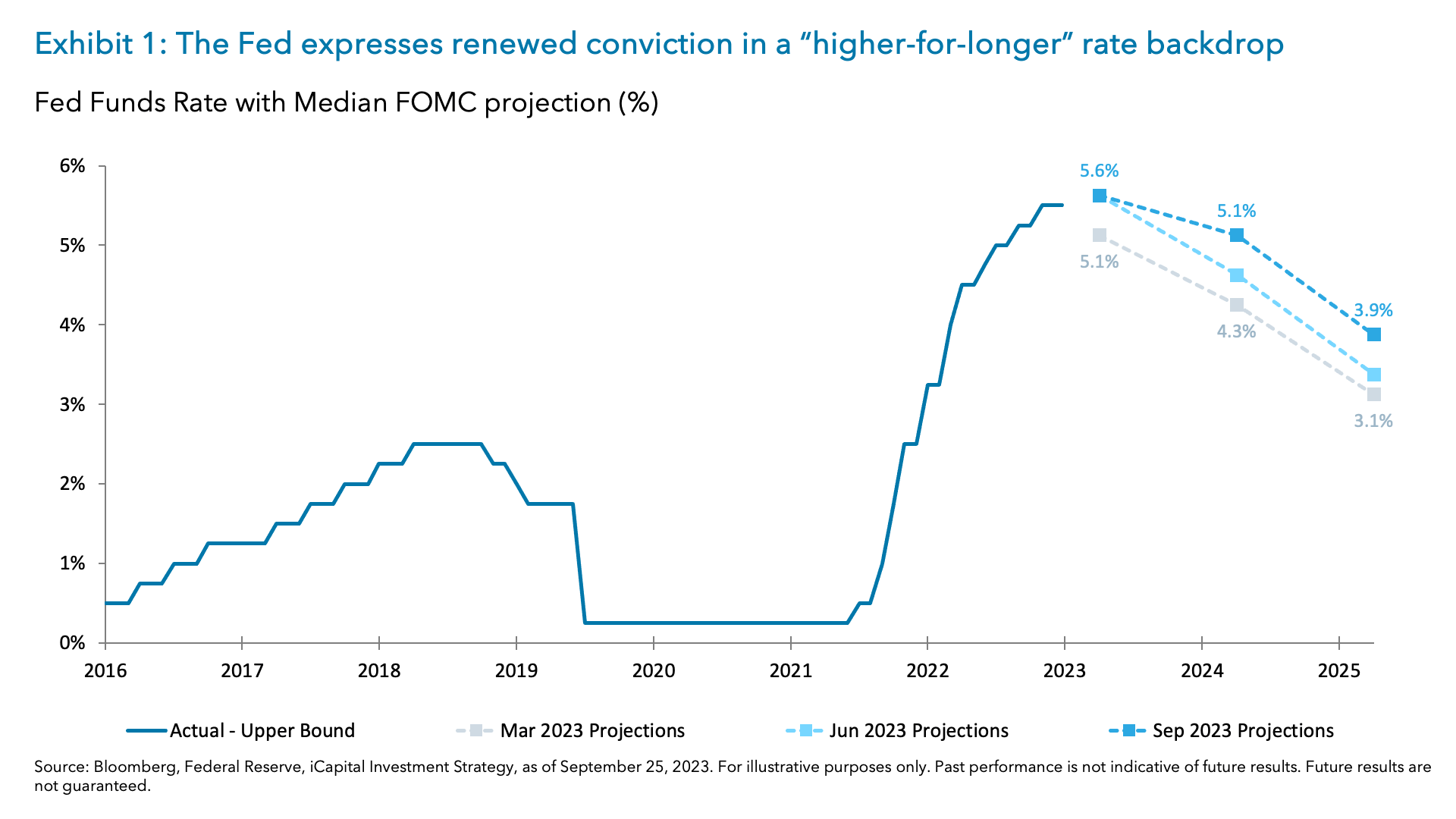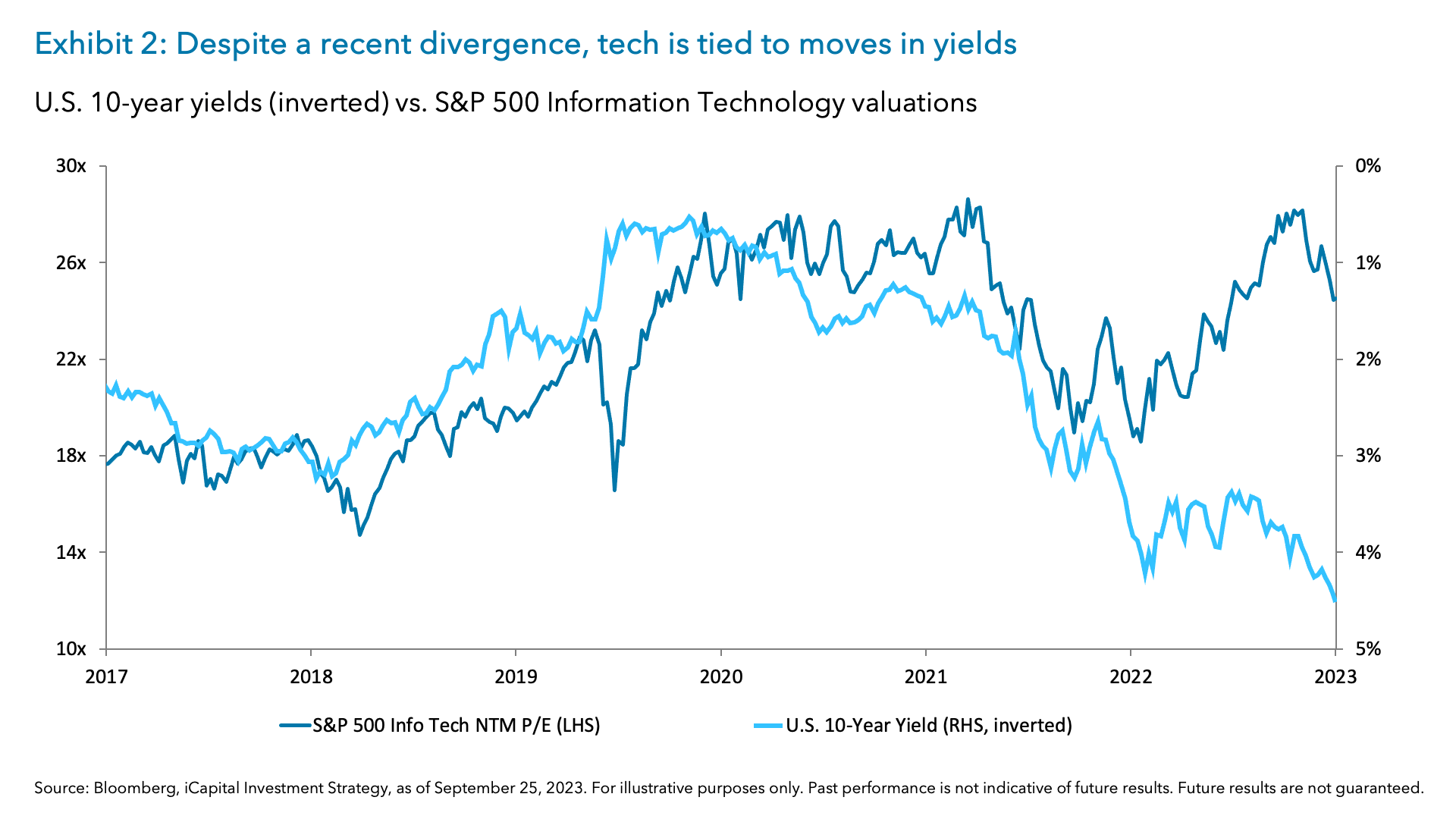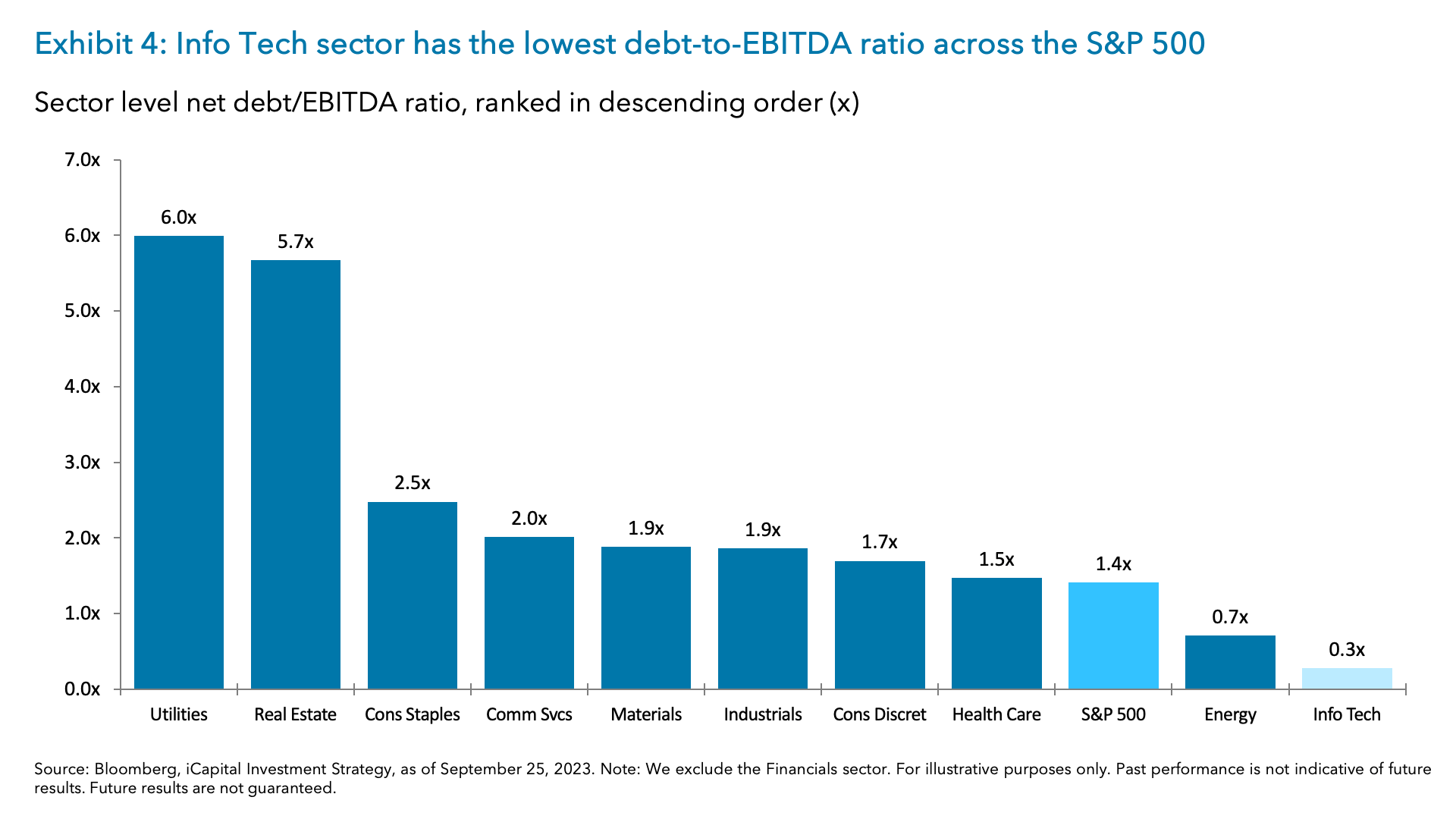So far this month, the market reacted to a toxic combination of an incrementally more hawkish Fed, deteriorating market technicals, and decidedly more bearish sentiment levels.1 Yields across the curve spiked while the S&P 500 is on track to finish September down -3.78% and the Nasdaq 100 is tracking -4.72%.2 September seasonality delivered.
Not surprising, the Federal Reserve’s September Federal Open Market Committee (FOMC) meeting was the focal point to the toxic brew, as we got an updated Summary of Economic Projections which showed renewed conviction in a “higher-for-longer” rate backdrop. The median FOMC participant now expects the fed fund rate to be 5.6%, 5.1%, and 3.9% in 2023, 2024, and 2025, respectively – up substantially from the first half of the year (Exhibit 1).3
Looking ahead, we acknowledge that there remains a confluence of negative near-term overhangs that the market must navigate through, including the potential U.S. government shutdown at the end of this week, resumption of student loan payments, the continued United Auto Workers (UAW) strike, higher oil prices, and lack of corporate buybacks from now and into October. However, on net, we view these developments as manageable headwinds which may dampen economic growth but not entirely derail it. We still see several reasons to remain constructive in segments of the market, including Energy and Tech, throughout the balance of the year.
1. After a stealth move higher in yields, a pause is likely
The Fed’s message of “high-for-longer” is now finally sinking in, and markets are appropriately adjusting. The yield on the U.S. 10-year Treasury note has moved far and fast, rising roughly 70 basis points (bps) since the end of second quarter 2023, and nearly 20 bps since the start of last week.4 However, we see scope for a pause to the yield rally given a multitude of factors. First, at 4.5%, the 10-year yield is now slightly above fair value.5 Second, this week’s Personal Consumption Expenditures (PCE) inflation report is expected to show a year-over-year drop in core inflation, from 4.2% in the prior month to 3.9%, prompting a pause in yields.6 Finally, as we head into the fourth quarter of 2023, we will likely see softer economic growth, due to a number of events – the potential U.S. government shutdown, the end of the reprieve on student loan repayments, auto worker strikes, headwind from oil prices on consumption, to name a few. While we don’t expect these factors to push fourth quarter GDP growth negative, they will indeed dampen growth, likely below the 1.5% potential GDP growth.7 Consensus now expects fourth quarter GDP growth to be +0.4% (seasonally adjusted annual rate), versus +4.9% that the Atlanta Fed GDPNow tracker estimates for the third quarter of 2023.8 When taken together, pressure on higher yields has likely reached local extremes and a pause around current levels would be a net positive for equity valuations, namely in the Tech sector (Exhibit 2).
2. Rates around current levels harken back to the “old normal” regime, but vulnerabilities across consumers and corporates remain in check
First, although a 10-year yield around 4.5% seems high in the context of the post-Global Financial Crisis (GFC) ultra-low yield environment, we view this as a return to the “old normal.” As we wrote about in our 2023 Back to School Market Outlook, in the 14 years following the GFC, U.S. 10-year yields averaged approximately 2.5%,9 but they averaged around 5.4% in the 15 years leading up to the GFC.10 A return to the “old normal” is a function of an economy that is resilient and can withstand a higher level of real rates. And despite prior high-rate environments, both public and private equity markets were able to deliver solid returns.11
Second, despite concerns about bubbles bursting due to higher rates, we don’t see major vulnerabilities across consumer or corporate balance sheets as rates reset. For consumers, only 11.1% of outstanding household debt is floating rate, up marginally from the historical low of 10.5% in the second quarter of 2022, but well below the near 25% and 22% seen at the start of the 1999-2000 and 2004-2006 hiking cycles, respectively.12 Similarly, for U.S. corporates (S&P 500), 7.9% of outstanding debt is floating rate, which is relatively low compared to roughly 54% at the end of 2007.13 Finally, debt levels for both consumers and corporates appear manageable. Consumer debt as a percentage of household net worth is approximately 13%, well below the 24% peak during GFC.14 And S&P 500 net debt to EBITDA is at 1.4x.15 Of course, going forward, we expect both consumers and corporates will use less leverage as it becomes incrementally more expensive, and the topic of the upcoming wall of maturities requires more careful scrutiny. In the coming weeks, we aim to frame out what an elevated, but more stable rate environment means across various pockets of the economy and where opportunities and risks may lie.
3. Surge in oil prices is unlikely to force the Fed to react or overact
Oil prices are up roughly 14% year-to-date, while the average national gasoline price has risen 20%.16 Despite the direct and indirect impulses of oil prices on the economy, we think the Fed is unlikely to react, or overact, as the U.S. economy has become less sensitive to oil prices. During the 1990s, every 10% rise in oil prices impacted core PCE inflation by more than 100 bps. Today, the cumulative impact of a 10% rise in oil prices is around 10 bps on core PCE inflation and 10-15 bps on core Consumer Price Index (CPI) inflation.17 That said, we expect the Fed to remain less concerned about movements in oil prices and more focused on housing and wages, which impacts inflation to a larger degree. Indeed, energy’s share of the overall CPI basket stands at just 7% (Exhibit 3).18 This compares to housing (shelter), which accounts for roughly 35% of CPI.19 And wage growth (up 5.3%) tends to impact service inflation, which is around 60% of CPI.20 So, the passthrough of higher oil prices is not likely to have as much of a material impact as the market may be fearing. We might see a scenario where headline inflation ticks higher, but the core doesn’t (or at least not as much), and the Fed is more likely to focus on that.
For investors, we’d use the spikes in yields to buy the dips in Tech (and stay long Energy stocks)
Given these considerations, we would remain long Energy stocks, as OPEC’s intent to keep prices elevated amidst declining global inventories is likely to keep Brent crude high-for-longer. Additionally, we’d use the spikes in yields to buy the pullbacks in areas such as Tech, especially when considering the tactical setup that is forming under the hood. A lot of bearish sentiment has now been priced-in to markets and the S&P 500 and Nasdaq 100 are beginning to screen close to oversold. At the same time, investor positioning is no longer stretched, as Commodity Trading Advisors (CTAs) having reduced equity exposure from highs (though they have capacity to reduce more over the near-term) and hedge funds having also been net sold for five out of the last six weeks.21 Additionally, there remains an immense amount of cash on the sideline with a near-record $5.6 trillion parked in money markets funds and mutual fund cash balances, which have reduced slightly, yet remain elevated.22
More fundamentally, we also view Tech – and especially Software – as well positioned even in the current market environment of higher rates. The sector has low leverage, and in fact the lowest in the S&P 500, so higher rates are a headwind to valuations, but not business fundamentals (Exhibit 4).23 And margins tend to be high and sticky – again especially for Software – compared to the rest of the S&P 500.24
Tech valuations have already corrected from their November 2020 peaks of 20x enterprise value (EV) to next twelve month (NTM) revenues, to 5.5x today.25 And Tech has low or no oil exposure in its cost structure unlike airlines, for example, where jet fuel is a key input cost.26
Finally, one additional and major reason why we favor Software is that the sub-sector should be a key beneficiary of artificial intelligence (AI), both on the revenue and cost side and both in the public and private markets. Software accounts for 88% of the estimated total addressable market (TAM) of AI (more on this here). Both private and public sector companies stand to benefit as they monetize AI by launching new AI software enabled products.27 And wages represent a high share of costs for the sector, but AI adoption can help reduce those costs due to automation.28 Given the multiple reasons above, we would use the spikes in yields to buy the dips in Tech, and especially Software.
1. Bloomberg, iCapital Investment Strategy, as of September 25, 2023.
2. Bloomberg, iCapital Investment Strategy, as of September 25, 2023.
3. Bloomberg, Federal Reserve, iCapital Investment Strategy, as of September 20, 2023.
4. Bloomberg, JPMorgan, iCapital Investment Strategy, as of September 25, 2023.
5. JPMorgan, iCapital Investment Strategy, as of September 25, 2023.
6. Bloomberg, iCapital Investment Strategy, as of September 25, 2023.
7. Bloomberg, Federal Reserve, iCapital Investment Strategy, as of September 25, 2023.
8. Bloomberg, Federal Reserve Bank of Atlanta, iCapital Investment Strategy, as of September 25, 2023.
9. Bloomberg, iCapital Investment Strategy, as of September 25, 2023.
10. Bloomberg, iCapital Investment Strategy, as of September 25, 2023.
11. Bloomberg, Preqin, iCapital Investment Strategy, as of September 25, 2023.
12. Fitch Ratings, “U.S. Consumption Boost from Pandemic Savings Expected to Fade”, as of June 15, 2023.
13. Bloomberg, iCapital Investment Strategy, as of September 25, 2023.
14. Bloomberg, iCapital Investment Strategy, as of September 25, 2023.
15. Bloomberg, iCapital Investment Strategy, as of September 25, 2023.
16. Bloomberg, iCapital Investment Strategy, as of September 25, 2023. Note: We use Brent crude for Oil and we use the AAA’s average price for retail gasoline for gasoline.
17. Goldman Sachs, Morgan Stanley, as of September 25, 2023.
18. Bloomberg, iCapital Investment Strategy, as of September 25, 2023.
19. Bloomberg, iCapital Investment Strategy, as of September 25, 2023.
20. Bloomberg, iCapital Investment Strategy, as of September 25, 2023.
21. Goldman Sachs, as of September 25, 2023.
22. Bloomberg, iCapital Investment Strategy, as of September 25, 2023.
23. Bloomberg, iCapital Investment Strategy, as of September 25, 2023.
24. Bloomberg, iCapital Investment Strategy, as of September 25, 2023.
25. JPMorgan, as of September 25, 2023.
26. Bloomberg, iCapital Investment Strategy, as of September 25, 2023.
27. International Data Corporation (IDC), “Worldwide Semiannual Artificial Intelligence Tracker,” as of July 29, 2022.
28. Goldman Sachs, as of August 21, 2023.
IMPORTANT INFORMATION
The material herein has been provided to you for informational purposes only by iCapital, Inc. (“iCapital”). This material is the property of iCapital and may not be shared without the written permission of iCapital. No part of this material may be reproduced in any form, or referred to in any other publication, without express written permission of iCapital.
This material is provided for informational purposes only and is not intended as, and may not be relied on in any manner as, legal, tax or investment advice, a recommendation, or as an offer to sell, a solicitation of an offer to purchase or a recommendation of any interest in any fund or security. You should consult your personal accounting, tax and legal advisors to understand the implications of any investment specific to your personal financial situation. This material does not intend to address the financial objectives, situation or specific needs of any individual investor. Alternative investments are complex, speculative investment vehicles and are not suitable for all investors.
The information contained herein is an opinion only, as of the date indicated, and should not be relied upon as the only important information available. Any prediction, projection or forecast on the economy, stock market, bond market or the economic trends of the markets is not necessarily indicative of the future or likely performance. The information contained herein is subject to change, incomplete, and may include information and/or data obtained from third party sources that iCapital believes, but does not guarantee, to be accurate. iCapital considers this third-party data reliable, but does not represent that it is accurate, complete and/or up to date, and it should not be relied on as such. iCapital makes no representation as to the accuracy or completeness of this material and accepts no liability for losses arising from the use of the material presented. No representation or warranty is made by iCapital as to the reasonableness or completeness of such forward-looking statements or to any other financial information contained herein.
Securities products and services are offered by iCapital Markets, an SEC-registered broker-dealer, member FINRA and SIPC, and an affiliate of iCapital, Inc. and Institutional Capital Network, Inc. These registrations and memberships in no way imply that the SEC, FINRA, or SIPC have endorsed any of the entities, products, or services discussed herein. Annuities and insurance services are provided by iCapital Annuities and Insurance Services LLC, an affiliate of iCapital, Inc. “iCapital” and “iCapital Network” are registered trademarks of Institutional Capital Network, Inc. Additional information is available upon request.
© 2023 Institutional Capital Network, Inc. All Rights Reserved.






















